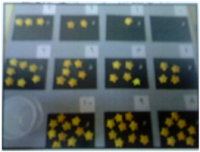 |
| Animals on Parade – Ordinals |
Students work independently creating a parade of animals. Laminated cards with pictures of mammals, birds, insects and spiders, reptiles, and fish are used. One an animal parade is established, the child place an ordinal numeral above the animals to signify their position in the parade. The number of animal cards provided to the child can vary depending upon the level of difficulty suitable for the child. The mammals, reptiles, and birds all face to the right while the insects and spiders and fish face to the left. Thus, parades can be arranged in either direction with the first animal at the head of the parade. The activity can be used either on a table or on the floor mat. Sets of animals can be mixed as long as the sets are facing in the same direction.
To Download Files:
 |
Candles on Cake |
Students like to work with manipulative materials, because of this, I believe that this activity will enhance a child learning. During this activity a child will count from 0 – 5 by placing candles on a picture of a birthday cake. The child will also learn to associate numerals with various quantities.
To Download Files:
 |
| Counting with Stars |
The child is going to do this task in Both Arabic and English languages individually. The child has to put the numbered cards in the correct order according to the language; and finally, he has to relate the quantities (number of stars) with the correct numerals.
To Download Files:
 |
| Dinosaur Rhythm Patterns |
Students work independently creating a pattern using images of dinosaurs. Laminated cards with pictures of sixteen different are available. At the beginning, stage a maximum of three dinosaur images can be used for any one pattern. The child at first attempts to match the simple pattern provided on one of the model cards. Letter cards are used to represent the dinosaurs so that a pattern rule or name can be shown. Pictures of ‘slaps’, ‘snaps’, and ‘claps’ are used in addition to the letters to show the hand movement to use to produce a sound pattern. Next, they attempt to extend the pattern keeping the same rhythm or beat.
To Download Files:
 |
| Felt Boards – Butterfly Symmetry |
Students work independently with a felt board background and the outline felt shape of a butterfly. They place small coloured geometric shapes on the two wings attempting match the shapes on one wing shapes of the type and colour on the opposite wing. They can either create the symmetrical pattern shape by shape or complete all the shapes on one wing before attempting to make the symmetrical match on the opposite wing.
http://www.slideshare.net/magicalbawadi/butterfly-outline-7974081
http://www.slideshare.net/magicalbawadi/stars-7974047
http://www.slideshare.net/magicalbawadi/squares-7974045
http://www.slideshare.net/magicalbawadi/shapes-for-butterflies
http://www.slideshare.net/magicalbawadi/triangles-7974046
http://www.slideshare.net/magicalbawadi/rectangles-7974040
http://www.slideshare.net/magicalbawadi/diamonds-7974039
http://www.slideshare.net/magicalbawadi/pentagons-7974036
http://www.slideshare.net/magicalbawadi/ellipses-7974037
http://www.slideshare.net/magicalbawadi/stars-7974047
http://www.slideshare.net/magicalbawadi/squares-7974045
http://www.slideshare.net/magicalbawadi/shapes-for-butterflies
http://www.slideshare.net/magicalbawadi/triangles-7974046
http://www.slideshare.net/magicalbawadi/rectangles-7974040
http://www.slideshare.net/magicalbawadi/diamonds-7974039
http://www.slideshare.net/magicalbawadi/pentagons-7974036
http://www.slideshare.net/magicalbawadi/ellipses-7974037
 |
| One Hundred Board |
Students work independently with a laminated one hundred board background to identify various types of number patterns. They place small coloured geometric shapes on the one hundred board or they use an erasable marker to highlight numbers on the board. They can either follow a pattern rule or create an original pattern of their own.
To Download Files:
http://www.slideshare.net/magicalbawadi/one-hundred-board-lt
http://www.slideshare.net/magicalbawadi/one-hundred-board
http://www.slideshare.net/magicalbawadi/circles-7974056
http://www.slideshare.net/magicalbawadi/one-hundred-board-lt
http://www.slideshare.net/magicalbawadi/one-hundred-board
http://www.slideshare.net/magicalbawadi/circles-7974056
http://www.slideshare.net/magicalbawadi/stars-7974070
http://www.slideshare.net/magicalbawadi/pentagons
http://www.slideshare.net/magicalbawadi/hexagons
http://www.slideshare.net/magicalbawadi/squares-7974068
http://www.slideshare.net/magicalbawadi/pentagons
http://www.slideshare.net/magicalbawadi/hexagons
http://www.slideshare.net/magicalbawadi/squares-7974068
 |
| Shapes feely bag. |
Only through their sense of touch, children will be searching for a certain shape (circle, square, rectangle, etc) which the teacher asks them to find from the opaque feely bag. They will insert one hand inside the feely bag and try to identify a particular shape using their prior knowledge about the features of each one.
Adding and removing shapes from the feely bag depends on each child’s level. Start with 4 shapes or less, and add some according to the child’s progress.
To Download Files:
 |
Size activity (Big, medium, and small) |
A child will arrange pictures under heading of ‘big,’ ‘medium,’ and ‘small.’
To Download Files:
http://www.slideshare.net/magicalbawadi/ss-7973670
http://www.slideshare.net/magicalbawadi/task-7973663
http://www.slideshare.net/magicalbawadi/pictures-7973661
http://www.slideshare.net/magicalbawadi/task-7973663
http://www.slideshare.net/magicalbawadi/pictures-7973661
 |
| Skip Counting – Dalmatians |
Students work individually using a set of picture cards and a die to create a set of cards that has an equal number of dogs to the number shown on the die. Three different sets of cards and dice are available; sets of two, sets of five, and sets of tens. These are used for separate activities. Once the die is cast the student must find a card with a matching numeral and place it on the surface. Next the student must use the picture cards to skip count up to the number that matches the numeral on the card. This process is repeated with several rolls of the die.
To Download Files:
http://www.slideshare.net/magicalbawadi/skip-counting-by-2shttp://www.slideshare.net/magicalbawadi/skip-counting-by-10s
In studying the number sense and numeration, students learn to demonstrate an awareness of addition. To have them be able to do that, we can use the manipulative to make stories about number. Stories are like equations where the child develops an understanding of ‘together with’ is the same of ‘+’ sign for a range of numbers (as the activity; 0+5 is the same of 5+0, 1+4 is the same of 4+1, etc). Also, they can begin writing simple equations to demonstrate the addition story.
To Download Files:
 |
| Less and More Watermelon |
Children will count the seeds from the original laminated watermelon pictures and find out a correct answer by counting the seeds from the individual cards. The teacher should not force the child to solve the problem in one way. The child can solve it in many ways just let him explore. This activity will enhance children's cognitive abilities for example; the child will acquire thinking and problem solving skills.
To Download Files:











0 comments:
Post a Comment